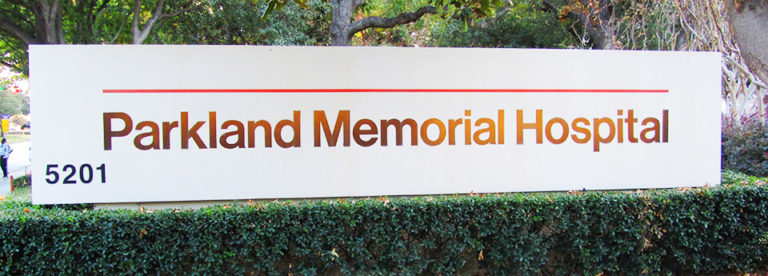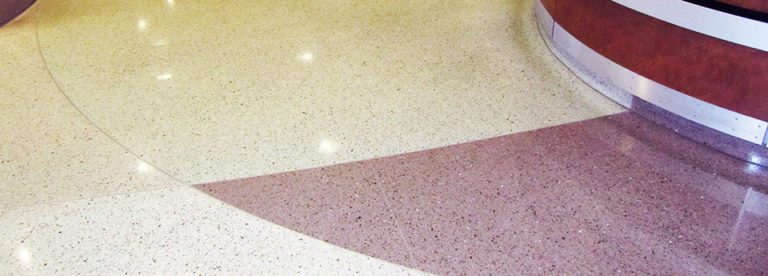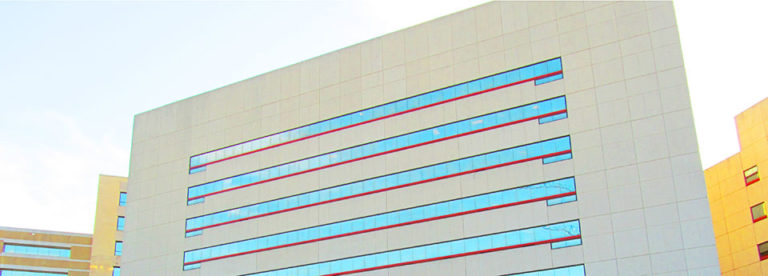Recycled Glass Opens the Floor to Creative Design
Case Study by William Feldman
Facility planners at Parkland Memorial Hospital in Dallas recently were faced with an interesting challenge as part of an extensive renovation of the main lobby: how to create a colorful, eye-catching, and easy-to-maintain floor that could be installed relatively quickly over the existing floor and would stand up well over time. The renovation included a large revolving door, front window system, lighting, information desk, and sprinkler system.
The goal for the architect and designers at the county facility was to find an attractive flooring product for the high-traffic area that could be laid with minimal preparation over almost 4,000 square feet of glazed brick pavers and thickset bedding. Removal of the existing floor would have been very difficult, time-consuming, dusty, and noisy.
Enter EnviroGLAS Products? recycled glass terrazzo, a new and innovative take on an old art form that has been a flooring option for centuries. The product fit the specification to a T. Surpassing marble in durability and designed to last 40+ years, the environmentally friendly terrazzo is composed of 100% post-consumer use crushed glass and color pigmented, VOC-free epoxy resin binder.
While the concept of using bits of glass mixed into traditional terrazzo for sparkle dates back more than 60 years, only in the past few years has it become economically viable to use glass as the main component. Formulated at about 75% glass and 25% epoxy by volume, the mix is non hazardous, non carcinogenic, odor free, and non-flammable.
“We liked the fact that EnviroGLAS has all the good qualities of terrazzo and require only minimal substrate preparation – removal of the glaze finish of the brick pavers, but not of pavers themselves, which could remain in place – and would not raise the floor height much beyond what it was,” says Thom Wilkins, a LEED-certified architect with the Facilities Development Department at Parkland Memorial. The installation, which was easy to float to the existing floor elevations at transition points at doorways, required only a 3/8-inch pour.
And unlike traditional marble and cement terrazzo, which porous and requires a sealant, neither the glass nor the epoxy is porous, and the installation did not require a sealant. In addition, the excellent natural chemical resistance of glass terrazzo meant that the floor would maintain its shine without need for polishing.
The custom mix of glass chips, selected from eight distinct recycled glass chip aggregates, and color-pigmented epoxy, available in an unlimited numbers of shades, resulted in a finished floor that complemented the new lobby d?cor. Recycled glass sources included mixed bottle glass, mirror glass, window plate glass, cobalt blue glass, green glass, and brown-amber glass.
The finished floor meets ADA standards (0.5 or higher) for traction and the new healthcare green building standard of the Green Guide for Healthcare (www.gghc.org) and can contribute to seven or more U.S. Green Building Council certified LEED points. Specially, the LEED potential is one to two points for “recycled content” credit, and one “indoor air emitting materials” credit.
The 4-inch high, curved terrazzo cover that runs around the perimeter of the lobby eliminates breaks where the walls and floor meet. As the floor has no seams or grout, there is no breeding ground on the floor for mold or mildew, so keeping the floor clean is easy. Aside from the occasional buffing, maintenance consists of wet or dry mopping as needed.
The poured-in-place terrazzo floor is manufactured on-site, minimizing post-commercial waste and transportation costs, and can be poured directly over just about any roughened substrate, including wood or concrete. In preparation for the new flooring, the top surface of the existing tile was ground down and then scored to a minimum depth of 1/8-inch to ensure a receptive surface for the epoxy.
After that, the installation was straightforward and formulaic. The contractor, American Terrazzo Company, of Garland, Texas, mixed about 90% of the glass chips and the epoxy and poured the mixture onto the floor, troweled it, and then spread the remaining chips atop the mixture and troweled again. This extra dollop of chips ensured and even, dense distribution of glass and optimized the surface shine.
To create a distinctive pattern, the lobby floor incorporated three colors and two widths of divider strips (3/8-inch and 1/2-inch). The two nonadjacent colors were poured simultaneously, with the third color poured about 24 hours later, after the two surfaces were dry enough to walk on. The subsequent three-stage grinding process gradually revealed the full luster, glimmer, and shine of the translucent glass chips.
The finished floor, which glistens when the sun shines on it through the windows, is “the best looking floor in hospital.” Wilkins notes. Recycled glass terrazzo flooring can enliven corridors, waiting rooms, and elevator lobbies in nearly all areas of hospital. (At the nearby Dallas-Fort Worth Airport, local artists created themed terrazzo installations for the people-mover lobbies in Terminal C. The abstract, colorful designs address movement and the flow of people in aesthetically pleasing ways.)
EnviroGLAS Products also offers recycled glass and epoxy terrazzo as factory-fabricated 6x36x3/8-inch planks which, grouted with stain-free epoxy grout, can be used to achieve a practically maintenance free, high-end wood floor look with a green non-wood product.
When it comes to putting creativity underfoot, recycled glass terrazzo seems to offer limitless possibilities.
About author: William Feldman writes frequently for trade and national magazines on building technologies.



